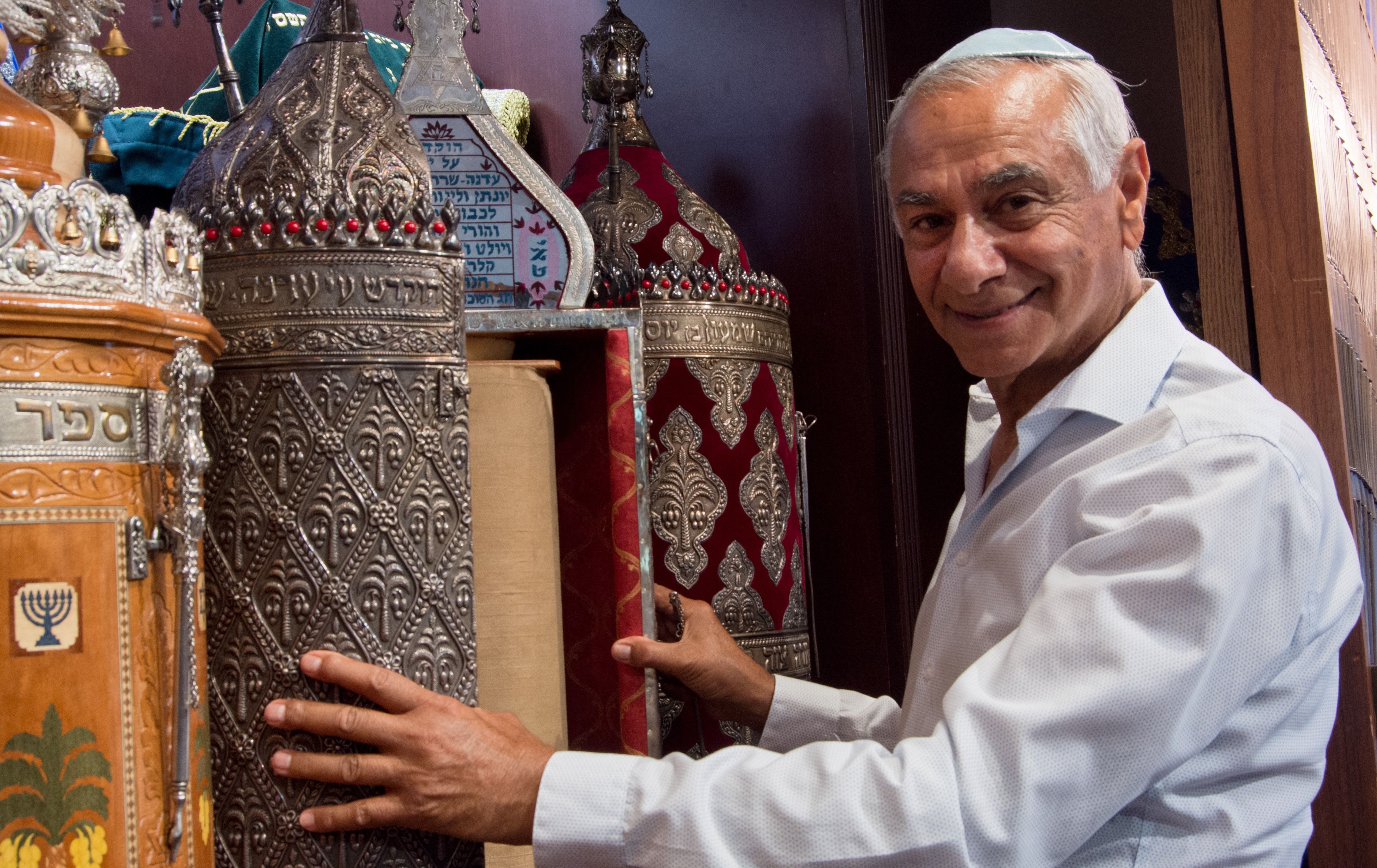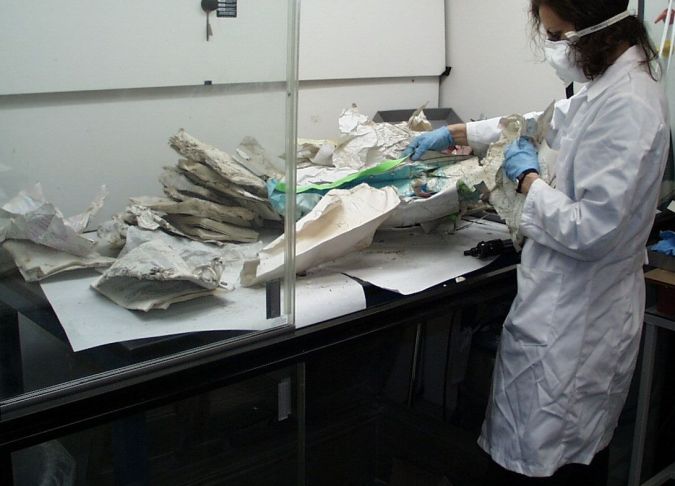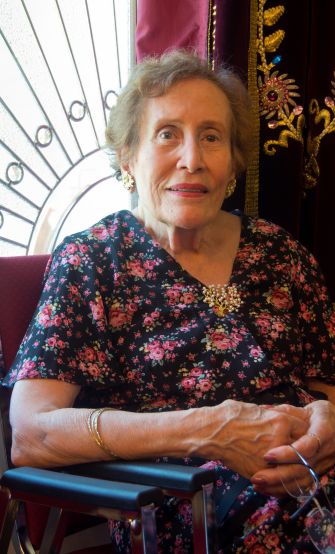In Exile, Iraqi Jews Are Desperate To Reclaim Their Artifacts
by Talia Zax

Shortly after the Iraqi Jewish Archive was found, Doris Hamburg, then director of preservation programs at the National Archives, and Mary Lynn Ritzenthaler, then the National Archives’ chief of conservation, were brought to Iraq to assess the archive’s condition. The materials had been stored in 27 metal trunks packed into a freezer truck. “When the doors were opened to the truck, the smell of mold was just overwhelming,” Hamburg said. Even so, she said, “we realized quite quickly that despite the dreadful condition and how they looked — one person recently told me that when he saw them, they looked like oatmeal — it would be possible to salvage them.”
On August 20, 2003, only three months after the archive was found, the United States entered into an agreement with Iraq’s Coalition Provisional Authority that allowed for the archive to be moved to America, where the National Archives would oversee its preservation. After preservation work was completed the archive would be returned to Iraq in June 2014.
The archive was shipped to Fort Worth, Texas, where it was freeze-dried en masse, a process that took weeks. The materials were then sent to the National Archives in College Park, Maryland. In 2005, the Center for Jewish History signed on to work with the National Archives on a “preliminary survey of the collection,” said Rachel Miller, now CJH’s director of archive and library services; CJH would go on to collaborate on the rest of the archive’s restoration.

“The materials were taken and mold was removed, [then] treatment was done to the extent that things could be imaged, because our goal was to put things online,” Hamburg said. Iraq’s agreement with the United States had allowed for the creation of a publicly accessible digital version of the entire Iraqi Jewish Archive, a project that was completed in 2014. An exhibit of some of the archive’s most impressive materials, including a late 19th- or early 20th-century tik and a 1902 Haggadah, debuted at the National Archives in November 2013.
The following month, a small portion of the Iraqi Jewish Archive found a final home when 49 fragments of religious scrolls, specifically the Torah and the Book of Esther, were buried in a genizah, or burial repository for sacred texts, at New York’s New Montefiore Cemetery. Those fragments had suffered extreme water damage, and rabbinical authorities declared them irreparable. Iraq’s ambassador at the time, Lukman Faily, collaborated with Hamburg and a delegate of Iraq’s minister of culture to review the fragments, and Faily himself attended the burial ceremony. Before the fragments were buried they were set out for the community to see. In photos from the event, people — beaming, snapping photographs, somber, some on the verge of tears — crowded around a table piled with scrolls.
In May 2014, Faily issued a statement declaring an extension of the period in which the archive would remain in the United States. A new return date was set for September 2018.
But resistance had been brewing against plans to send the archive back at all.
In 2010, B’nai B’rith International wrote to then-secretary of state Hillary Clinton appealing for a turnabout on the agreement, and in 2014 the Senate passed a unanimous resolution requesting that President Obama’s administration come to an agreement with Iraq that wouldn’t result in the archive’s repatriation to Baghdad. Iraqi officials were resistant. In 2010, Saad Eskander, then director of Iraq’s National Library and Archive, told the Los Angeles Times the collection should return to Iraq. Eskander said: “Jews are Iraq’s oldest community. They are a significant part of the history of establishing Iraq.”
In September 2017 it seemed the battle might be over; a State Department spokesman confirmed to JTA that the United States intended to honor the terms of the agreement to send back the archive in 2018. But many were reluctant to give up the fight. The next month, Senate Minority Leader Charles Schumer wrote to then-secretary of state Rex Tillerson, urging a different resolution. “Since the exile of Jews from Iraq,” he wrote, “virtually no Jewish life remains in the country — this treasured collection belongs to the Jewish community and should be made available to them.” Schumer was echoing sentiments that Iraqi Jews like Bakhash, Basri and Alice Aboody had been espousing for years.
The Trauma of Escape
When life gets difficult, Aboody, 82, looks to the past. “Who are my ancestors? What are my roots?” she said. We were speaking in the sanctuary of Bene Naharayim with some of the synagogue’s other longtime members. “I wrote a poem about a tree that was dying, but the roots were very deep and found water. When I wrote that poem I wasn’t even aware I was really writing about the tree of life. To me, these archives are my roots.”

Aboody grew up in Iran, born to Iraqi parents who relocated after her father suffered an anti-Semitic assault in Baghdad. She immigrated to the United States when she herself was married. Then, in 1969, she said, “the brother of one of my late husband’s classmates was hanged openly in Baghdad, in front of his family.
“We — the Iraqi Jews of New York —about 65, 70 people, we decided we have to do something. At that time, hardly anybody had heard of Saddam Hussein. We started to write letters to the United Nations. They wanted to meet with some of us, and we [explained] that people were being hanged, innocent people, they just were accused [of being] a Zionist.
“They would not allow the Iraqi Jews to get out anymore. The passports were confiscated. So we raised, really, a lot of noise. It grew to be 2,000 [protesters]. It was very powerful, and we did get the results; a few people who were in jail were let go,” Aboody said. “I was threatened; the president of our committee, he used to wear a little revolver, because he was threatened. One time, the father of my kids said, ‘We have three children; they’re going to kill you.’ And I said: ‘I don’t care. Even though I was not born in Iraq, my parents were Iraqis. How can you stand people being slaughtered or abused like that?’”
After the hangings, Aboody’s sister-in-law’s brother was among those tortured in jail. So was the brother of Jamil Heardoon, 74.
“You will be the next, you think,” Heardoon said. His family had stayed in Iraq after the aliyah of 1950–51 because he and his two siblings had been young at the time, and his parents didn’t want to take the risk of leaving. He ultimately left in 1970, when he was 27, escaping to the north of Iraq and then, with assistance from the local Kurds, to Iran.
Everyone I spoke to at Bene Naharayim had personal stories about the impossibility of Jewish life in Iraq after 1948 and the trauma of escape: A friend who returned home from college to find that her family had been killed; relatives arrested abruptly, with little official word about where they’d been taken; cruel smugglers who, during the crossing into Iran, scared children for fun; people bundling into taxis before dawn, without a clear sense of where they were going. Penina Offrey, who goes by the name Lulu, was the daughter of a woman who made clothing for Iraq’s king and queen. Her mother, who grew up with Violet Bakhash, later had to bribe the government to keep her husband out of jail.

Just as common as those stories, still vivid after decades, is the absolute belief that the archive belongs pretty much anywhere except Iraq.
“The Jewish community has repeatedly had inquiries from the State Department to fund the restoration, to fund exhibits,” Basri told me. “Our answer: Why would we fund something that’s going to be here temporarily? It should be ours.”
Heardoon told me, firmly, that the question of the archive’s future is “the biggest issue” in his community. “I don’t want to remember anything about Iraq,” his wife, Lamaan, told me. “I want everything back. We’re where it belongs.”
“When I go to the cemetery, in front of that grave, the tomb where all these destroyed Torahs are buried, I feel like I’m praying at the tomb of my ancestors,” Aboody said. “Because they’re all buried in Iraq. I feel it in my blood. I cannot visit their grave. But I can visit where they used to put their hand on one of these Torahs, and pray.”
Yet according to Ambassador Yasseen, Iraq also has a deep emotional tie to the archive. “People remember, vividly, what happened in the 1960s, the public hangings after the Baath Party coup in 1968,” he said. “The Jews were the canaries in the mine.”
For him, the archive’s testament to the communal Jewish life Iraq extinguished is a testament to the many communities destroyed by Hussein. And Yasseen, like many Iraqis, has a personal attachment to the country’s Jewish history. He told me that in the farhud of 1941, a pogrom in which an estimated 180 Jews were killed, his father and uncle both “stood guard at the door of their Jewish neighbor’s house.” He wants Iraq to honor the bonds that led his father and uncle to risk their lives for Jews, not absorb the ideas that put Jewish lives at risk in the first place.
“Take a notebook of a schoolchild, or the minutes of a chamber of commerce,” he said. “What it will give you is a tangible feel that there was a real community.”
In contemporary Iraq — a country in which minority communities’ recent history was defined first by suffering at the hands of Hussein and then the scourge of ISIS — the desire to reclaim that sense of communal history is understandable. It also raises an important question: Does the Iraqi Jewish Archive belong where it can comfort Iraqi Jews? Or does it belong in their homeland, where it can help humanize them to generations for whom the idea of Iraqi Jews is ancient history, and, to some, a contradiction in terms?
[ original here ]
Category: Baghdad, Heritage, Justice for Jews of Arab Countries, Preservation Promotion Education



